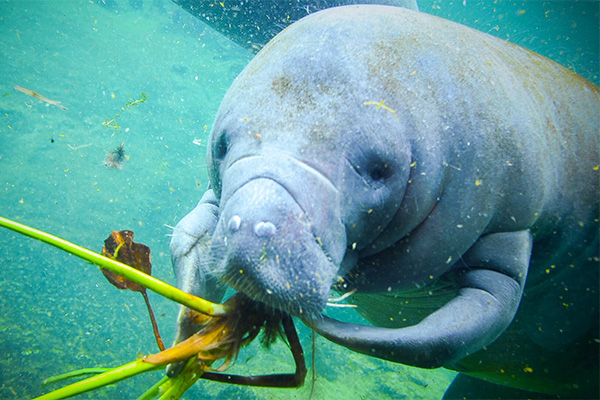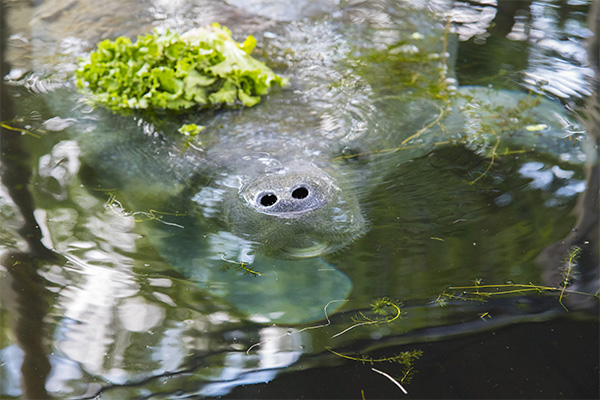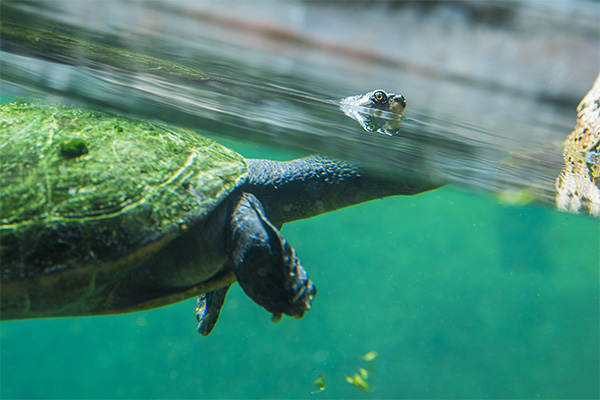They may no longer be considered “endangered,” but Florida’s growing manatee population continues to face various challenges out in the wild. However, the USF College of Public Health is coming to the rescue of these beloved sea creatures, still listed as a “threatened” species.
The USF Health college is training veterinary physicians through innovative research and biostatistical data to help improve the health of manatees and other wildlife.
This is made possible through a Veterinary Public Health Postdoctoral Fellowship created in partnership between USF College of Public Health and Tampa’s Lowry Park Zoo.
“Public health is about preventing disease in human populations, but it’s extremely exciting to add the animal population to our work,” said Kathleen O’Rourke, PhD, professor and chair of the Department of Epidemiology and Biostatistics at the USF College of Public Health. “In this program, the college works with the zoo to train veterinarians in evidenced-based research and epidemiology to help improve the overall health of animals.”
During the two-year program, students study epidemiology, biostatistics and conduct research for publication, as well as learn health care skills, clinical techniques and hands-on rescue and rehabilitation. They also receive training in indoor air-quality, animal nutrition and other subspecialties.

Melissa Nau, DVM, postdoctoral fellow at USF and full-time veterinarian at Tampa’s Lowry Park Zoo, works together with the Tampa’s Lowry Park Zoo veterinarian team to take blood samples from an injured manatee – submitted into the zoo’s manatee critical care center –David A. Straz Jr. Manatee Critical Care Center. The sea mammal has been injured by a boat strike and has a hard time diving.
Melissa Nau, DVM, postdoctoral fellow at USF and full-time veterinarian at Tampa’s Lowry Park Zoo, is one of the first fellows to train through this collaborative program.
“As part of the veterinary team, I help provide rehabilitation and critical care to injured manatees and conduct hands-on research,” said Dr. Nau, who started the program in August 2016. “By working closely with these wild animals and conducting research about them, we help advance the level of medical care that we can provide as well as improve our understanding of wild populations.”
The fellowship, which is funded through Joy McCann Foundation, also provides fellows with a full-time veterinarian position at the Tampa’s Lowry Park Zoo – bringing a wealth of knowledge to the zoo veterinarian team. Since this partnership began, the zoo, which cares for more than 1,300 hundred animals, has released more than 70 percent of its patient manatees back into the wild.

(L to R). Ray Ball, DVM, director of medical services at Tampa’s Lowry Park Zoo, Dr. Nau and Kathleen O’Rourke, PhD, professor and chair of the Department of Epidemiology and Biostatistics at the USF College of Public Health, at Tampa’s Lowry Park Zoo.
Ray Ball, DVM, director of medical services at Tampa’s Lowry Park Zoo, said the zoo is optimistic about the partnership with USF. He said he hopes this collaboration will lead to a better understanding of manatees and other animals to help improve their overall health.
“Through this partnership, we’ve conducted a 25-year retrospective epidemiological survey of every manatee that’s come through the hospital,” said Dr. Ball. “From this data, we know why they were admitted, where they were admitted, the age they were admitted, how long they were here, did they survive and where there were released. Looking retrospectively, we can also study the manatees’ obstacles and challenges – looking at blood values, prognostic indications, pregnancy and reproduction rates, as well as help evaluate and predict survivability and discover ways to help them live healthier lives.”
In the last 20 years, Tampa’s Lowry Park Zoo, one of the most popular zoos in the southeastern United States, has received more than 400 manatees for treatment. Dr. Ball said that they now have a strong database they can analyze and from which some solid conclusions can be drawn.
According to U.S. Fish and Wildlife Service, there are significant improvements among the manatee populations and its habitat, however; they still face many challenges in the wild.
“Manatees continue to deal with natural and man-made challenges,” Dr. Ball said. “Some of the injuries that we see include boat strikes, canal blocks, cold stress, red tide and others. But, we hope that through our efforts and discoveries, we can help make their lives better and safer.”
Dr. Nau, who is receiving two different post-graduate certifications through this program, said she is living her dream through this fellowship.
“I wanted to be a zoo vet since I was a child, so I have my dream job — caring for animals that I love and educating people about them,” Dr. Nau said. “This opportunity is very unique as it allows me to further my education in epidemiology and research. This background is going to be a huge benefit to my career as a zoo veterinarian.”
Story by Vjollca Hysenlika, USF Health Communications and Marketing
Video and Photos by Ryan Noone, USF Communications and Marketing




